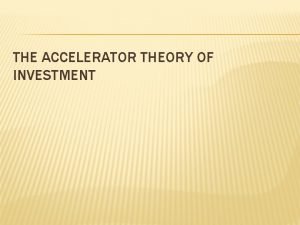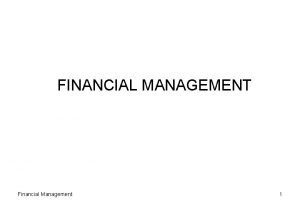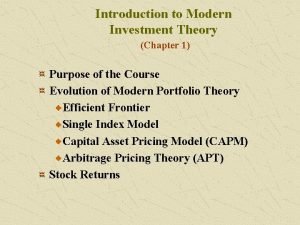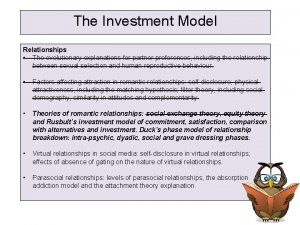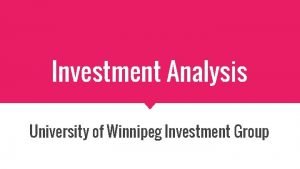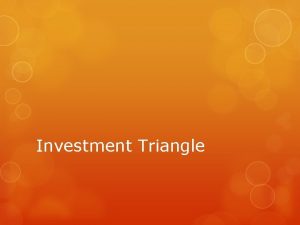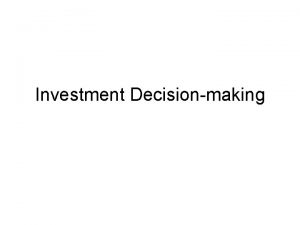FIN 6160 Investment Theory Lecture 3 4 How



















- Slides: 19

FIN 6160 Investment Theory Lecture 3 -4

How Securities are Traded §Primary Market: When firms need to raise capital they may choose to sell or float securities. These new issues of stocks, bonds, or other securities typically are marketed to the public by investment bankers in what is called the primary market. §There are two types of primary market issues of common stock. Initial Public Offerings or IPOs are stocks issued by a formerly privately owned company that is going public by selling stock to the public for the first time. Seasoned or Right equity offerings are offered by companies that already have floated equity. For example a sale of new shares of stock by Square Pharmaceuticals would constitute a seasoned or right new issue. Mohammad Kamrul Arefin, MSc. in Quantitative Finance, University of Glasgow 2

How Securities are Traded §In case of bonds we also distinguish between two types of primary market issues, a public offering and a private placement. §A public offering of bond refers to an issue of bonds sold to the general investing public that can then be traded on the secondary market. §Private placement of bonds refers to an issue that usually is sold to one or a few institutional investors and is generally held to maturity. §Secondary Market: Secondary market facilitate trading of existing securities among investors. Mohammad Kamrul Arefin, MSc. in Quantitative Finance, University of Glasgow 3

§Securities Firms: Securities firms may provide single or all of the following variety of functions in financial markets: 1) Broker 2) Underwriter 3) Dealer §Broker: Brokers charge a fee for securities transactions between two parties §Underwriter or investment banker: Some securities firms place newly issued securities in the primary market for corporations and government agencies §When securities firms underwrite newly issued securities, they may sell the securities at a guaranteed price or at the best price for a client. §Another investment banking activity offered by securities firms is advisory services on mergers and other forms of corporate restructuring. §Securities firms may not only help a firm plan its restructuring but also execute the change in the firm’s capital structure by placing the securities issued by the firm. §Dealer: Securities firms often act as dealers, making a market in specific securities by adjusting their inventory of securities. A dealer’ income is influenced by the performance of the security portfolio maintained. Mohammad Kamrul Arefin, MSc. in Quantitative Finance, University of Glasgow 4

§Buying on Margin: When purchasing securities, investors have easy access to a source of debt financing called broker’s call loans. The act of taking advantage of broker’s call loans is called buying on margin. §Purchasing stocks on margin means investors borrows part of the purchase price of the stock from a broker. The margin in the account is the portion of the purchase price contributed by the investor, the remainder is borrowed from the broker. All securities purchased on margin must be maintained with the brokerage firm as collateral for the loan. §Short Sales: Normally, an investor would first buy a stock and later sell it. With a short sale, the order is reversed. A short sale allows investors to profit from a decline in a security’s price. An investor borrows a share of stock from a broker and sells it. Later the short seller must purchase a share of the same stock to replace the share that was borrowed. This is called the covering the short position. §The short seller anticipates the stock price will fall, so that the share can be purchased later at a lower price than it initially sold for, and reap a profit out of it. Mohammad Kamrul Arefin, MSc. in Quantitative Finance, University of Glasgow 5

Regulation on Securities Markets §In general, securities markets are regulated to ensure that the participants are treated fairly. Many regulations were enacted in response to fraudulent practices. §Since the use of incorrect information can result in poor investment decisions, many regulations attempt to ensure that businesses disclose accurate information. Securities Act was enacted to ensure complete disclosure of relevant financial information on publicly offered securities traded in the primary market and secondary market. §Securities and Exchange Commission (SEC) was established to oversee the securities markets. A variety of deceptive practices was declared illegal, such as misleading financial statements and trading strategies designed to manipulate the market price, insider trading etc. Mohammad Kamrul Arefin, MSc. in Quantitative Finance, University of Glasgow 6

Regulation on Securities Markets §Insider Trading: Security market regulation also prohibit insider trading. It is illegal for anyone to transact in securities to profit from inside information, that is, private information held by officers, directors, or major stockholders that has not yet been divulged to the public. §But the definition of insiders can be ambiguous. While it is obvious that the chief financial officer of a firm is an insider, it is less clear whether the firms biggest supplier can be considered an insider. Yet a supplier may deduce the firm’s near term prospects from significant changes in orders. The distinction between legal private information and illegal inside information can be fuzzy. §The SEC requires officers, directors, and major stockholders to report all transactions in their firm’s stock. Mohammad Kamrul Arefin, MSc. in Quantitative Finance, University of Glasgow 7

Investment Companies §Investment companies are financial intermediaries that collect funds from individual investors and invest those funds in a potentially wide range of securities or other assets. Pooling of assets is the key idea behind investment companies. Each investor has a claim to the portfolio established by the investment company in proportion to the amount invested. These companies thus provide a mechanism for small investors to team up to obtain the benefits of large scale investing. §Investment companies perform several important functions for their investors: §Record keeping and administration: Investment companies issue periodic status reports, keeping track of capital gains distribution, dividends, investments, redemptions, and they may reinvest dividend and interest income for shareholders. §Diversification and divisibility: By pooling their money, investment companies enable investors to hold shares of many different securities. They can also act as large investor. Mohammad Kamrul Arefin, MSc. in Quantitative Finance, University of Glasgow 8

Investment Companies §Professional management: Many investment companies have full time staff of security analysts and portfolio managers who attempt to achieve superior investment results for their investors. §Lower transaction costs: Because they trade large blocks of securities, investment companies can achieve substantial savings on brokerage fees and commissions. §Mutual Funds: Mutual funds sell shares to surplus units and use the funds received to purchase a portfolio of securities. Some mutual funds concentrate their investment on capital market securities like stocks and bonds while others, known as money market mutual funds, concentrate on money market securities. §By purchasing shares of mutual funds, small savers are able to invest in a diversified portfolio of securities with a relatively small amount of funds. Mohammad Kamrul Arefin, MSc. in Quantitative Finance, University of Glasgow 9

Investment Companies §Hedge Funds: Like mutual funds, hedge funds allow private investors to pool assets to be invested by a fund manager. Unlike mutual funds, however, hedge funds are commonly structured as private partnerships and thus subject to only minimal SEC regulation. They typically are open only to wealthy or institutional investors. Many hedge funds require investors to agree for lock ups that periods as long as several years in which investment can not be withdrawn. §Lock ups allow hedge funds to invest in illiquid assets without worrying about meeting demands for redemption of funds. Because hedge funds are only lightly regulated, managers can pursue risky investment strategies like heavy use of derivatives, short sales, etc. Mohammad Kamrul Arefin, MSc. in Quantitative Finance, University of Glasgow 10

Determinants of Interest Rates §Interest rate movements have a direct influence on the market values of debt securities, such as money market securities, bonds, mortgages and have an indirect influence on equity security values. §Following factors have direct or indirect impact on interest rate movement in the economy: §Demand & Supply of loanable funds §Economic growth §Inflationary expectation §Money supply §Budget deficit §Foreign flow of funds Mohammad Kamrul Arefin, MSc. in Quantitative Finance, University of Glasgow 11

Returns and Risk §Holding Period Return: §Including dividend: §Continuously compounded return : Mohammad Kamrul Arefin, MSc. in Quantitative Finance, University of Glasgow 12

Returns and Risk §Expected Return: This is the return that an investor expects a security to earn over the next period. Off course this is only an expectation, the actual return may be either higher or lower. An investor’s expectation may simply be the average return period a security has earned over the past. §Risk: The uncertainty about the future return from an investment is called the risk or volatility and can be measured using variance or standard deviation of the return. Mohammad Kamrul Arefin, MSc. in Quantitative Finance, University of Glasgow 13

Returns and Risk Security A B C D Rate of return Prob Rate of Prob return Rate of Prob. return 6% 1 5% 1 -10% ¼ -20% ¼ 0 ¼ 10 ½ 20 ½ 40 ¼ §Expected return: §Security A: 6% §Security B: 5% §Security C: -(0. 25 x 10%)+(0. 25 x 0)+(0. 5 x 20%) =7. 5% §Security D: -(0. 25 x 20%)+(0. 5 x 10%)+(0. 25 x 40%) =10% Mohammad Kamrul Arefin, MSc. in Quantitative Finance, University of Glasgow 14

Returns and Risk Purchase price=$100 State of the Year-end Cash Prob Holding Period Return (HPR) Economy price Dividends Boom Normal 0. 3 0. 5 129. 5 110. 0 4. 5 4. 0 (129. 5+4. 5 -100)/100=0. 34 (110+4 -100)/100=0. 14 Recession 0. 2 80. 5 3. 5 (80. 5+3. 5 -100)/100=-0. 16 Expected Return = (0. 34 x 0. 3)+(0. 14 x 0. 5)+(-0. 16 x 0. 2) =0. 14 Mohammad Kamrul Arefin, MSc. in Quantitative Finance, University of Glasgow 15

Returns and Risk §Portfolio Expected Return: When we invest on more than one asset, the portfolio expected return is the weighted average of the expected returns of all asset held in your portfolio. §If wi are weights, i. e. the investment proportions. §And E(Ri) expected return on individual asset, we have: §Calculate the expected return on a portfolio that has one third of your wealth invested in GM and two thirds in BP; Year Probab. GM BP Portfolio 2 ¼ 0. 10 0. 15 0. 1333 ¼ -0. 05 0. 10 0. 05 ¼ 0. 08 0 0. 0267 ¼ 0. 15 -0. 01 0. 0433 0. 07 0. 0633 Expected Rate of return Mohammad Kamrul Arefin, MSc. in Quantitative Finance, University of Glasgow 16

Returns and Risk §Covariance and Correlations: Returns on individual securities are related to one another. Covariance is a statistic measuring the inter-relationship between two securities. Alternatively, this relationship can be restated in terms of the correlation between the two securities. Mohammad Kamrul Arefin, MSc. in Quantitative Finance, University of Glasgow 17

Returns and Risk State of the Economy Rate of Return from Security A Rate of Return from Security B Boom Normal Recession Depression -20% 10% 30% 5% 20% -12% 9% Mohammad Kamrul Arefin, MSc. in Quantitative Finance, University of Glasgow 18

Returns and Risk §Variance of a portfolio: The formula for the variance of a portfolio composed of two securities A and B is: §Out of $100, if an investor invests $60 in Security A and remaining $40 in security B, then the variance of the portfolio, Mohammad Kamrul Arefin, MSc. in Quantitative Finance, University of Glasgow 19
 Spf fin fod fin
Spf fin fod fin Fin fin
Fin fin Nbr de esgoto
Nbr de esgoto Soal bangun ruang sisi lengkung smp kelas 9
Soal bangun ruang sisi lengkung smp kelas 9 Fixed investment and inventory investment
Fixed investment and inventory investment 01:640:244 lecture notes - lecture 15: plat, idah, farad
01:640:244 lecture notes - lecture 15: plat, idah, farad Criticism of accelerator theory of investment
Criticism of accelerator theory of investment Modern financial theory
Modern financial theory Personal investment theory
Personal investment theory Modern investment theory
Modern investment theory Rusbult's investment model
Rusbult's investment model Parental investment theory
Parental investment theory Natural language processing nlp - theory lecture
Natural language processing nlp - theory lecture Bayesian decision theory lecture notes
Bayesian decision theory lecture notes Bayesian decision theory lecture notes
Bayesian decision theory lecture notes Natural language processing nlp - theory lecture
Natural language processing nlp - theory lecture Bottle rocket fins design
Bottle rocket fins design Viaje a paris fin de curso
Viaje a paris fin de curso Skull fin fish
Skull fin fish Al final del tubo
Al final del tubo






